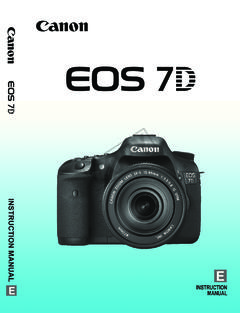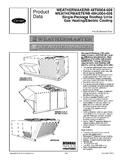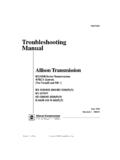Transcription of RaspiCam(Documentation - Raspberry Pi
1 RaspiCam Documentation July 2013 This document describes the use of the three Raspberry Pi camera applications as of July 2013. There are three applications provided: raspistill, raspivid and raspistillyuv. Both raspistill and raspistillyuv are very similar and are intended for capturing images, while raspivid is for capturing video. All the applications are command-line driven, written to take advantage of the mmal API which runs over OpenMAX. The mmal API provides an easier to use system than that presented by OpenMAX. Note that mmal is a Broadcom specific API used only on Videocore 4 systems.
2 The applications use up to four OpenMAX(mmal) components - camera, preview, encoder and null_sink. All applications use the camera component: raspistill uses the Image Encode component, raspivid uses the Video Encode component, and raspistillyuv does not use an encoder, and sends its YUV or RGB output direct from camera component to file. The preview display is optional, but can be used full screen or directed to a specific rectangular area on the display. If preview is disabled, the null_sink component is used to 'absorb' the preview frames. It is necessary for the camera to produce preview frames even if not required for display, as they are used for calculating exposure and white balance settings.
3 In addition it is possible to omit the filename option, in which case the preview is displayed but no file is written, or to redirect all output to stdout. Command line help is available by typing just the application name in on the command line. Setting up the camera hardware Please note that camera modules are static-sensitive. Earth yourself prior to handling the PCB: a sink tap/faucet or similar should suffice if you don t have an earthing strap. The camera board attaches to the Raspberry Pi via a 15-way ribbon cable. There are only two connections to make: the ribbon cable need to be attached to the camera PCB and the Raspberry Pi itself.
4 You need to get it the right way round, or the camera will not work. On the camera PCB, the blue backing on the cable should be facing away from the PCB, and on the Raspberry Pi it should be facing towards the Ethernet connection (or where the Ethernet connector would be if you are using a model A). Although the connectors on the PCB and the Pi are different, they work in a similar way. On the Raspberry Pi, pull up the tabs on each end of the connector. It should slide up easily, and be able to pivot around slightly. Fully insert the ribbon cable into the slot, ensuring it is straight, then gently press down the tabs to clip it into place.
5 The camera PCB itself also requires you to pull the tabs away from the board, gently insert the cable, then push the tabs back. The PCB connector is a little more awkward than the one on the Pi itself. You can watch a video showing you how to attach the connectors at (scroll down for the video). Setting up the Camera software Execute the following instructions on the command line to download and install the latest kernel, GPU firmware and applications. You will need an internet connection for this to work correctly. sudo apt-get update sudo apt-get upgrade Now you need to enable camera support, using the raspi-config program you will have used when you first set up your Raspberry Pi.
6 Sudo raspi-config Use the cursor keys to move to the camera option and select enable. On exiting raspi-config it will ask to reboot. The enable option will ensure that on reboot the correct GPU firmware will be running (with the camera driver and tuning), and the GPU memory split is sufficient to allow the camera to acquire enough memory to run correctly. To test that the system is installed and working, try the following command: raspistill -v -o The display should show a 5-second preview from the camera and then take a picture, saved to the file , while displaying various informational messages.
7 Troubleshooting If the camera is not working correctly, there are number of things to try. Are the ribbon connectors all firmly seated and the right way round? They must be straight in their sockets. Is the camera module connector firmly attached to the camera PCB? This is the connection from the smaller black camera module itself to the camera PCB. Sometimes this connection can come loose. Using a fingernail, flip up the connector on the PCB, then reseat it with gentle pressure, it engages with a very slight click. Have sudo apt-get update and sudo apt-get upgrade been run?
8 Has raspi-config been run and the camera enabled? If things are still not working, try the following: Error : raspistill/raspivid not found. This probably means your update/upgrade failed in some way. Try it again. Error : ENOMEM displayed. Camera is not starting up. Check all connections again. Error : ENOSPC displayed. Camera is probably running out of GPU memory. Check in the /boot/ folder. The gpu_mem option should be at least 128. If, after all the above, the camera is still not working, it may have a defect (most likely because it has suffered static shock).
9 Try posting on the Raspberry Pi forum in the camera board section to see if there is any more help available there. Common Command line Options Preview Window --preview, -p Preview window settings <'x,y,w,h'> Allows the user to define the size and location on the screen that the preview window will be placed. Note this will be superimposed over the top of any other windows/graphics. --fullscreen, -f Fullscreen preview mode Forces the preview window to use the whole screen. Note that the aspect ratio of the incoming image will be retained, so there may be bars on some edges.
10 --nopreview, -n, Do not display a preview window Disables the preview window completely. Note that even though the preview is disabled, the camera will still be producing frames, so will be using power. --opacity, -op Set preview window opacity Sets the opacity of the preview windows. 0 = invisible, 255 = fully opaque. Camera Control Options --sharpness, -sh Set image sharpness (-100 to 100) Set the sharpness of the image, 0 is the default. --contrast, -co Set image contrast (-100 to 100) Set the contrast of the image, 0 is the default --brightness, -br Set image brightness (0 to 100) Set the brightness of the image, 50 is the default.








